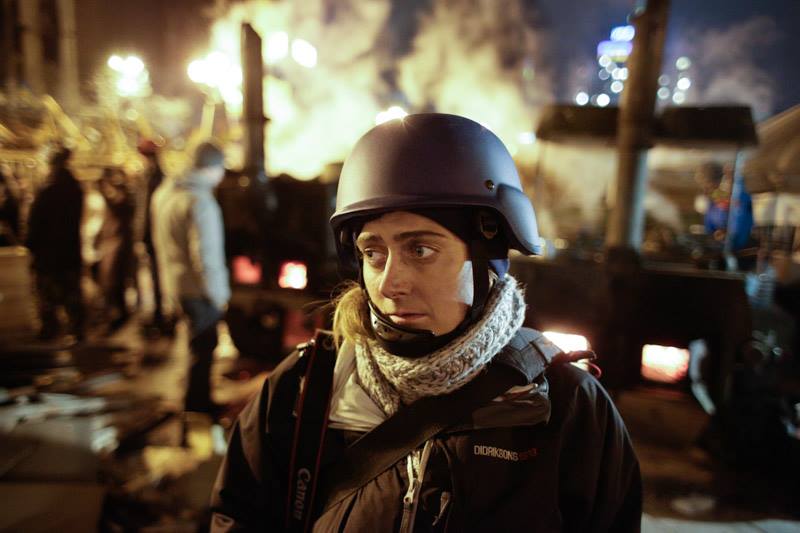
TED Fellow Anastasia Taylor-Lind on the other side of the camera in Ukraine. She originally planned to photograph a series about the declining population in the country, but quickly realized that the protests were her story. Photo: Alexander Checkmenev
When Anastasia Taylor-Lind found herself in Kiev at the height of violence during Ukraine’s Independence Square protests, the documentary photographer decided to record not the fighting itself, but the human beings involved. Setting up a makeshift photo studio in an alleyway inside the barricaded square, she beckoned passers-by — the protesters themselves, and later the women who came to mourn their deaths — and captured their images on film, using a medium-format camera. The result is a hauntingly intimate, arresting set of portraits that gives a sense of the ordinary people in an extraordinary moment, and gender roles in conflict situations.
As events continue to unfold after Ukraine’s parliamentary elections last Sunday, Taylor-Lind tells the TED Blog about her experiences during those harrowing days.
Why were you in Kiev during the protests? Did you go to cover it as a photojournalist?
I initially traveled to Ukraine as part of a wider, long-term project I’m working on called Negative Zero, that looks at Europe’s declining populations. There are 19 countries inside Europe that have declining populations, and Ukraine is one of them. I had been to Romania, Serbia and Nagorno-Karabakh already, and Ukraine was next on my list. And actually, even before the war, Ukraine had the lowest life expectancy for men inside Europe.
So I traveled to Ukraine with the idea that I was going to photograph a story about winter deaths. I was going to look at TB dispensaries, AIDS hospices and palliative care — or the lack of it — for cancer patients, and the elderly. I arrived in Kiev and was researching how to facilitate access to these places that actually all lay in Donbass, in the east of Ukraine. It is a war zone today, but it was peaceful at that time. While there, I started photographing the protests in Maidan.
I knew the protests were going on. Corruption and depopulation are two very closely linked issues — and these were essentially anti-corruption protests, so already there was some relevance. Once I started photographing in Maidan, and particularly working on the portraits, I knew that I had to stay, and that my story was there.
I was in Ukraine again in August, and I tried to reach some of the places I had initially planned to photograph, but they were cut off by the fighting, so I wasn’t able to follow up my initial plan.
What are some factors for low life-expectancy in Ukraine?
Smoking, alcohol and drug addiction, poverty, poor access to health care — and now war.
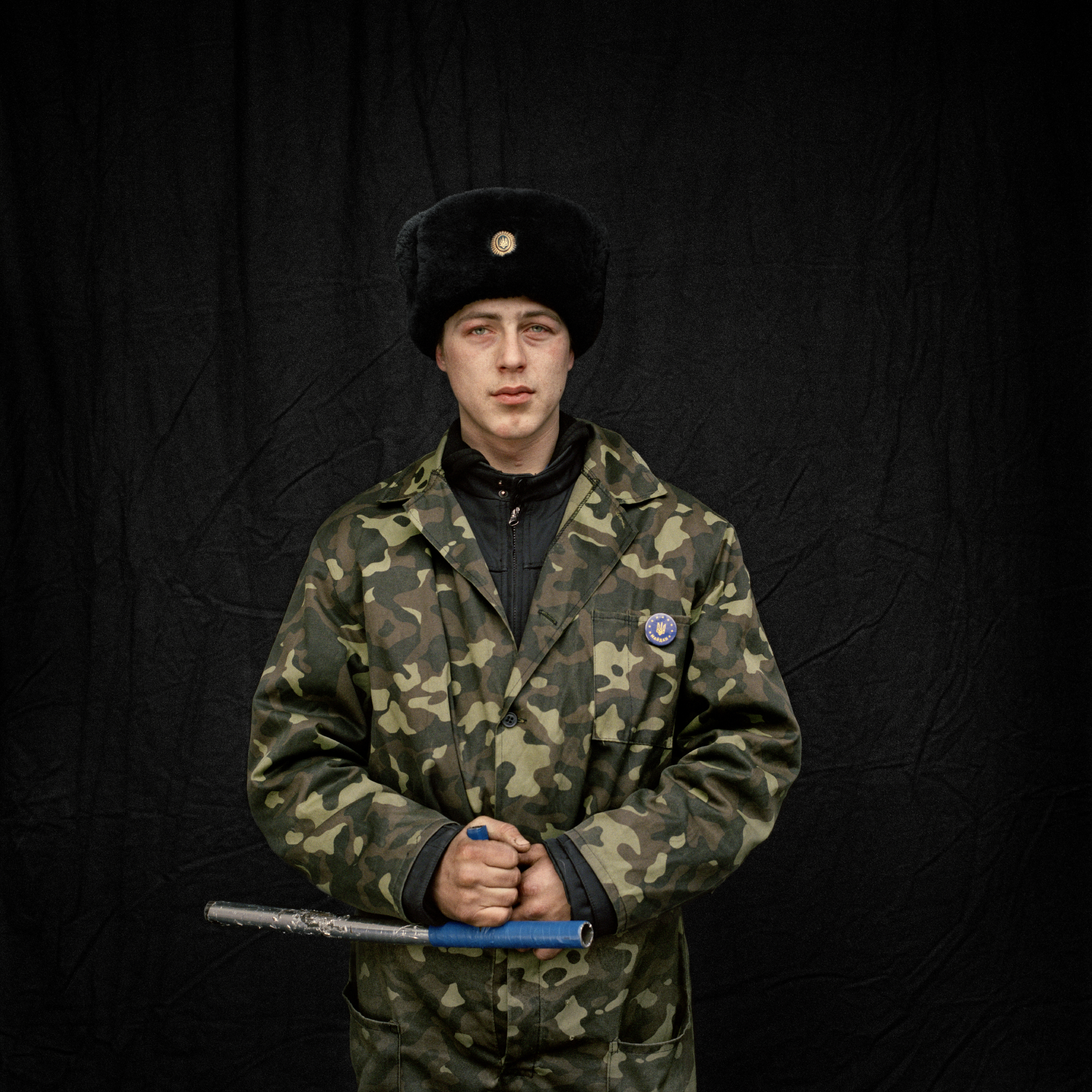
Serhiy, 19. Protestor from Obuhiv. February 26, 2014. Photo: Anastasia Taylor-Lind
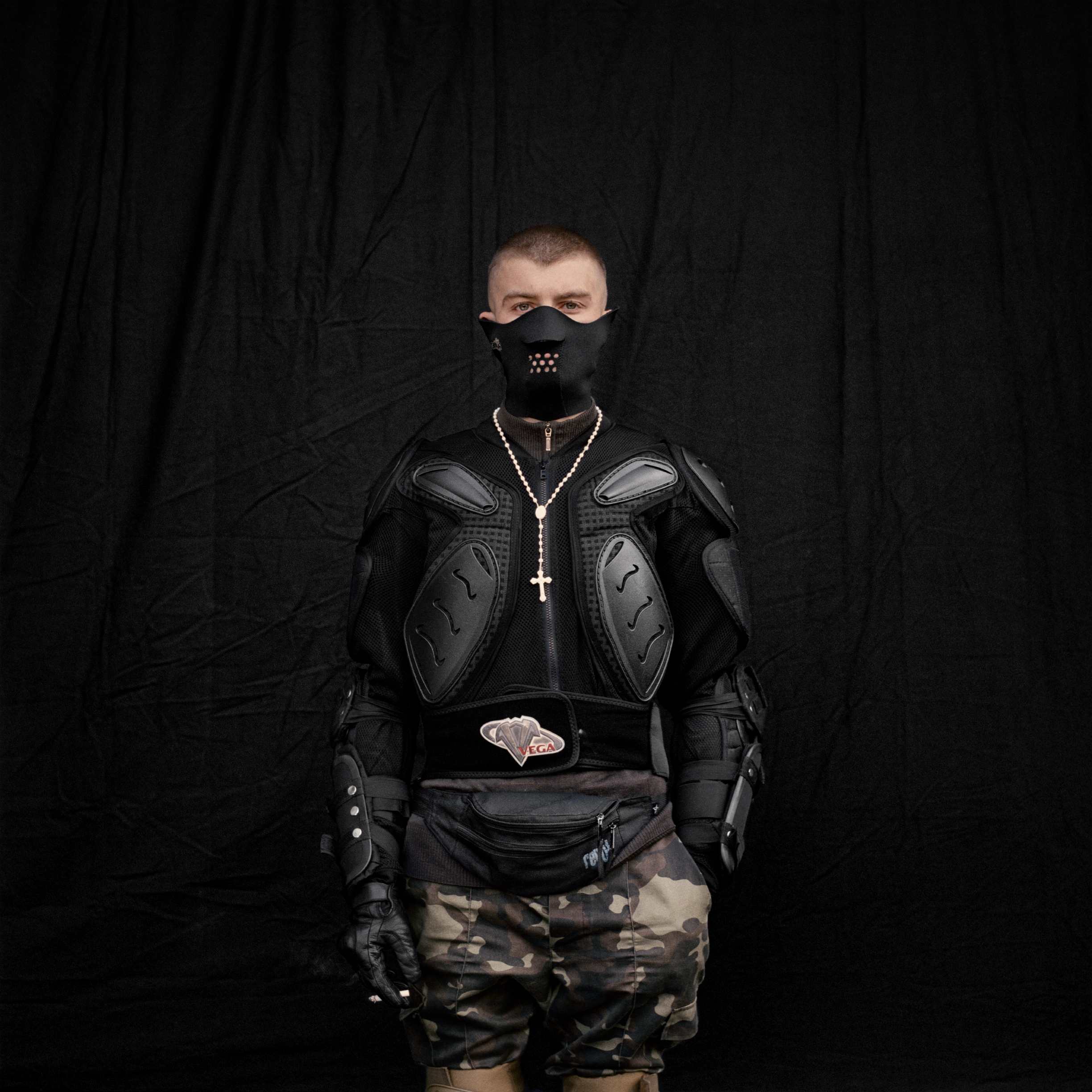
Eugene, 22. Protestor from L’viv region. February 24, 2014. Photo: Anastasia Taylor-Lind
You’re primarily a documentary photographer. What made you decide, in that moment, to shoot portraits?
I had never done a portrait series before. But I made my decision to shoot portraits in reaction to the presence of so many other journalists in Kiev and in Maidan. It was a news event, and I was working alongside so many of my colleagues and my friends. That’s really unusual for me — I’m not used to working surrounded by other photographers. Of course, if I’d been the only photographer in Kiev, I wouldn’t have shot the portraits — I would have had to take reportage pictures to show you what was happening. But the presence of all of the other photographers made me understand that I didn’t have to tell the whole story as one individual — what I could do was contribute one small part to the collective recording and collective understanding of the events there. Acknowledging that and trying to find one thing — one way to talk about it, the way that only I could talk about it — led me to making these portraits.
I’d been in a news situation once before, in Libya, during the revolution in 2011, and I’d felt a similar frustration. It’s not necessary to repeat news pictures that other people are taking; as a photographer, you have to not just find something to say, but you have to find your own way to say it. I struggled with that in Libya, and then the idea came to me, I should make portraits — both of the journalists as well as the fighters. Because what I noticed in Libya was that we photographers were emulating the costumes of the rebels.
That sounds dangerous!
It’s something that happens naturally, I guess. Not that photographers were wearing combat clothing, but they had a similar look: hipsterish, skinny jeans, beards, the checked scarves. When I was in Kiev, I noticed the same thing: we all looked like the fighters, like somehow we were all choosing the same clothes. This reminded me that I’d had this idea to take portraits in Libya, but I hadn’t done it, because I’m not a portrait photographer, I’m a reportage photographer. This time, it was the photographers around me who said, “That’s a good idea, you should do it!” So in a way, the presence of all the other journalists pushed me to do something different from them. It helped me to push myself creatively.
All the people you photographed were in the middle of either fighting or mourning. How did you get them to agree to stand still for a portrait?
My portrait studio was by the barricades on Hrushevskoho Street, inside the barricade of Maidan. I set up my studio there every day in the same place. It was a collapsible metal frame with a black muslin curtain. I placed it in a bricked-up alleyway, so it was set back a little bit, and my fixer Emine had a gold reflector to bounce the light onto the subjects. We stood there all day.
That spot was on a thoroughfare leading to the barricades, the front line with the Berkut, the police. So we’d stop people as they were passing and ask them to come to the studio. After the worst days of violence — February 18 through the 20th, 2014 — all of these fighters were joined by tens of thousands of civilians in the square. Many women came to lay flowers for the people who had been killed — they started laying the flowers at the points where people had died, which you could tell because there was the blood on the ground. People set up small shrines and put crosses there. Eventually the whole square was covered in millions of flowers.
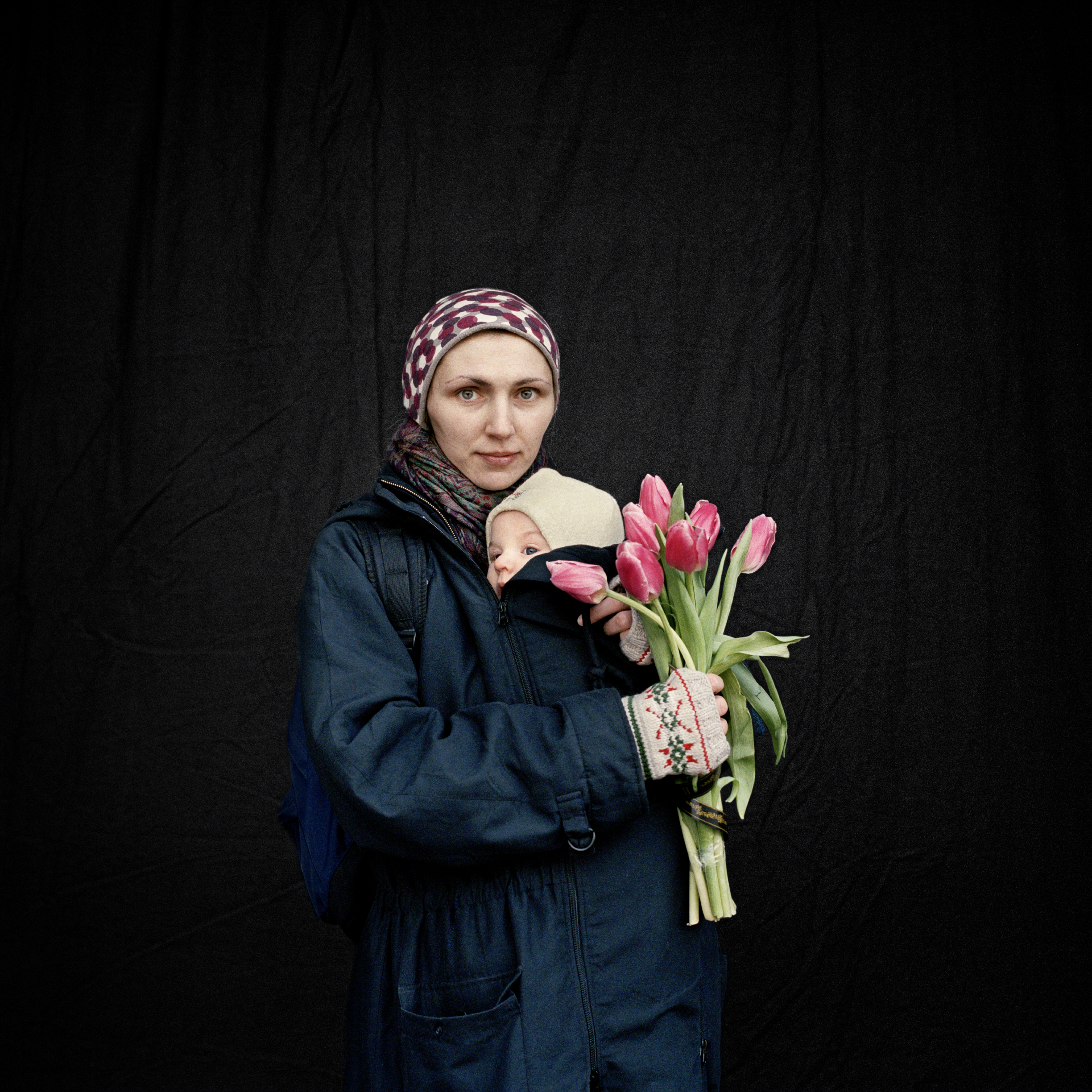
Olena, 26, and her 6-month-old baby Ostap. Mourner from Kiev. February 26, 2014. Photo: Anastasia Taylor-Lind
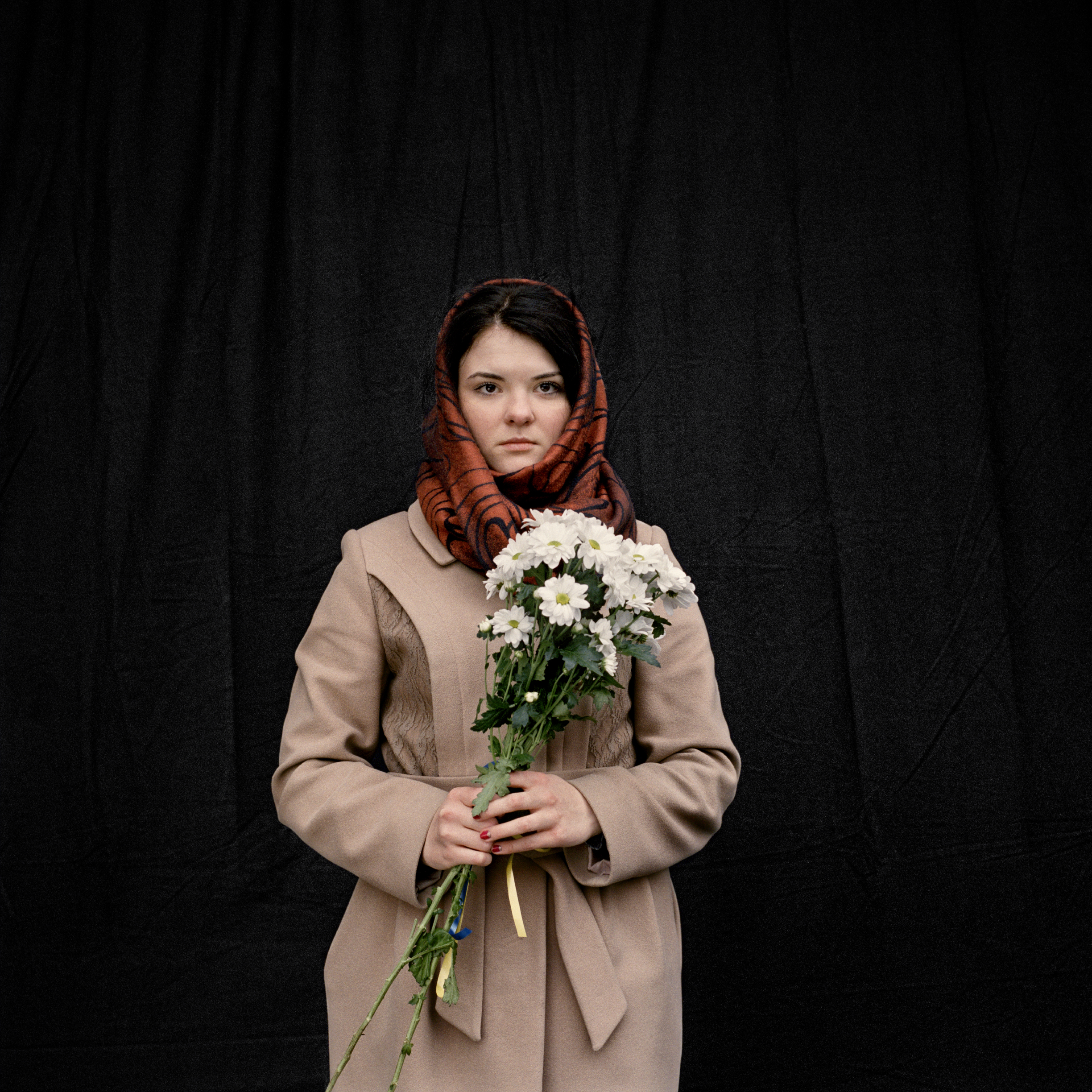
Natasha, 21. Mourner from Kiev. February 23, 2014. Photo: Anastasia Taylor-Lind
Did you have to stop yourself from taking pictures of other things going on?
It was really hard, because I’m a trained photojournalist. For example, as I was taking pictures of the women mourners, funeral processions were going by. The body of almost every man that was killed in Maidan was brought to the square in an open casket before being taken for burial. Their families carried them, singing the national anthem. At that time, I really felt torn that I needed to photograph this, and sometimes I did leave the studio to photograph that. But I had to remind myself that I had my one small part to tell, and I should do that well.
Of course, on the days when the worst violence happened, I wasn’t able to set up my studio. The square was on fire and there were lines of bodies laid out on the street, so I couldn’t work in that way. And I also had an assignment for a German newspaper, so I was shooting 35mm digital pictures that I was filing each day.
With all of this going on, how did you manage to convince these people to come into your studio? They must have thought you were nuts.
I would say 98% of people said yes. The only people who said no were the fighters under command. Sometimes the women said no if they were very upset, if they were crying a lot. They might say, “I want to be helpful, but look at me, the mascara is down my face!” And so we would explain, “But look at all of us. This is how we show what’s happening.” And so they would say, “Yeah, okay, I get it.”
How long were you there?
I was there for one month — I arrived on February 1 and left on the last day of February. During that time I went back to London for a weekend halfway through, because my mom was coming to visit — and thank god I did, because I discovered that both of my cameras had broken in ways that it was not possible to know, and all my photos were ruined. I had made about 150 portraits and only five of them came out. So I had to repair both cameras, and I realized I had to start from the beginning.
Oh no! You were using a Bronica?
I had a Bronica and a Hasselblad. The reason I use two cameras is because, when you’re shooting film, you don’t always know if there is a problem. If one camera breaks, you only lose half the film. In this case, they both broke — which had never happened in all of the time I’ve been a photographer. In hindsight, it was the thing that made me realize that I had to do this project, because it made me realize how much I cared about it.
Above: A grid of iPhone videos recording the scene through Taylor-Lind’s Broncia viewfinder as she shoots analogue film portraits in Maidan, with the sounds and music of the Square.
You also created a live video of your portrait process from within the camera. Did you do this because your cameras broke, and you wanted a backup?
No. I had decided that I was going to engage wholeheartedly with social media when I started Negative Zero. In my opinion, social media isn’t just another platform to publish the same kinds of pictures that you’d see in an exhibition, a book, or in a newspaper or magazine. It’s an opportunity to create images that you wouldn’t have made otherwise. So I started thinking about how I wanted to use it.
I decided that I wanted to share with my audience the experience of what it’s like to be a photographer. I realized if I was going to show what it was like for me, then I had to show people how I see the world. I never see my pictures like you will see them, as prints or in a book or on a screen. The only way I could see the world like that is if I put my camera down and just looked at it. But I never do. I only see the world through this viewfinder, held here at the height of my belly button. It’s square, it’s frosted, and you see people moving in mirror image: left to right, back to front.
So my assistant built this special iPhone arm that fixes the phone to my camera, so that I could shoot videos as well while holding the camera with both hands. And you can hear my voice. I’d move the phone out of the way, focus, compose, take my manual light meter reading, and then when ready, I’d move the iPhone back. And then I’d be looking through the iPhone into the camera. In the film, you see the click, and the screen goes blank, and then I wind the film.
How did you decide you wanted to be a photojournalist?
I decided that I wanted to become a photojournalist when I was 17. I’d studied photography in high school and fell in love with it. The first reportage pictures I saw were by an English photographer named Don McCullin. I found his book of pictures from the Vietnam War at school. It really stopped me in my tracks for two reasons. First, I didn’t know that things like this happened in the world. It was so raw on the front line, his pictures of American soldiers fighting in Hue. And secondly, I was shocked that there was someone whose job it was to be there and to photograph it. I took the book to my teacher and said, how do I learn how to do this? He said, “There’s one school in the world, a documentary photography bachelor’s in Newport, South Wales, and you should study there.” It was the only school I applied to.
Newport teaches you all the conventions of photojournalism. When we started out, we only shot with one lens — black-and-white film only, no flash, for a whole year, to learn the photojournalistic conventions of a photo-story. And then the second year, we were told to forget about all of it and start working in a more contemporary way. It’s really the only course in the world that gives you those two sides.
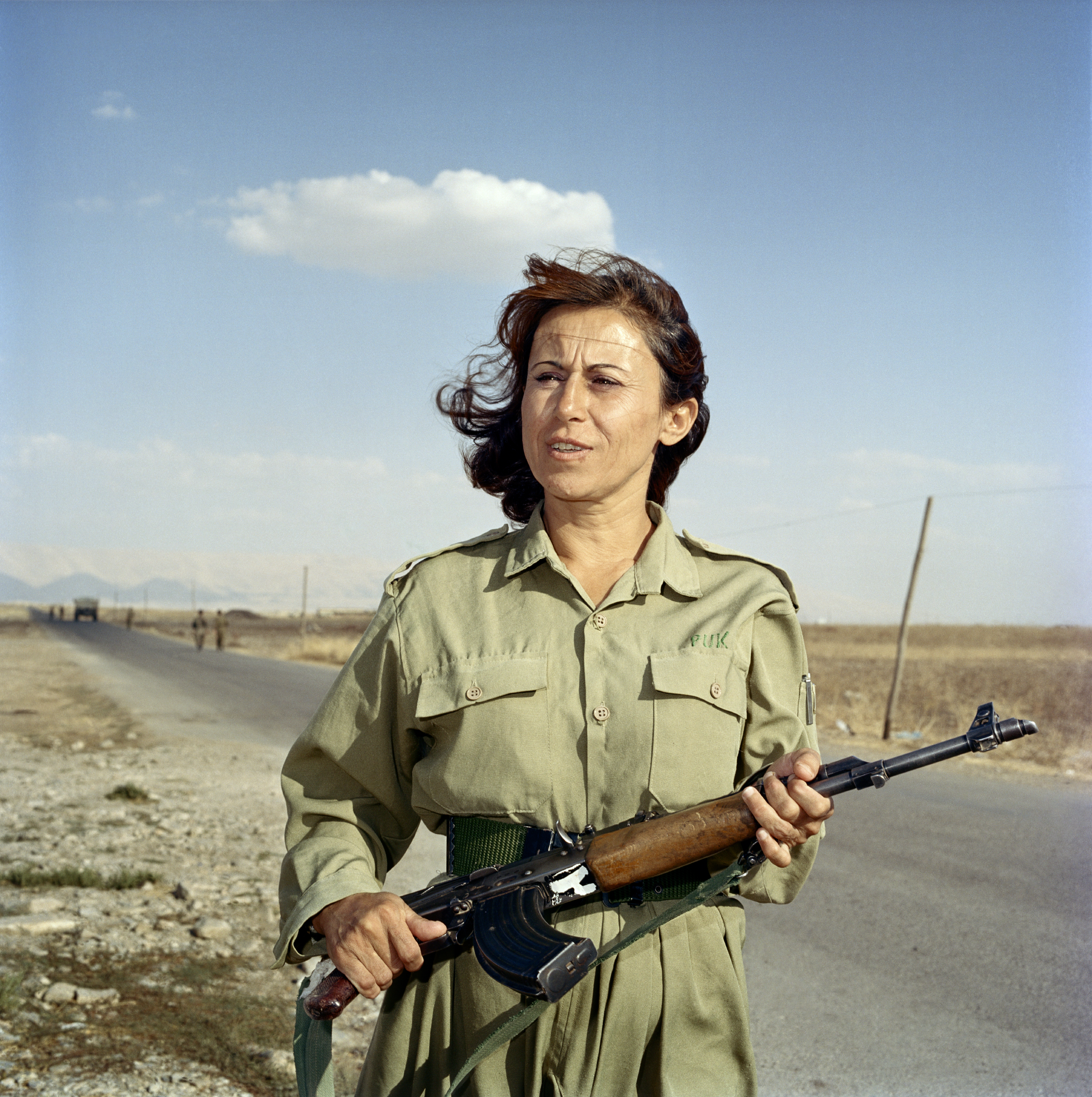
Gashaw Jaffar, a Peshmerga soldier, guards a checkpoint at the Farmanday Peshmerga base outside Sulaimaniyah, Kurdistan, Iraq. September 2003. Photo: Anastasia Taylor-Lind
How did you start covering conflict zones?
I first went to Kurdistan in Iraq when I was 22, to do a story about the Peshmerga women. At that time, the Peshmerga were considered to be more of a guerrilla army, but now they’re more like a conventional army. In 2003, when I first photographed them, the Peshmerga had been coordinated by the Americans and British in the invasion of Iraq. I was there two days ago photographing the same unit, and now they are fighting ISIS. But I was able to find some of the same women that I photographed 11 years ago.
But it’s not conflict itself that interests me anymore. Maybe that was the initial draw, but I’m not a war photographer. Most of my work is related to issues around conflicts, but it’s not like Don McCullin’s pictures from Vietnam. That was just what led me in this direction.
What next?
I am continuing my long-term project Negative Zero, about European population decline, which I’ll be working on for the next few years. As always I’m balancing this with editorial assignments. Next week, I’ll be in India, shooting a story about climate change.
Signed, limited-edition copies of Maidan: Portraits from the Black Square (GOST, July 2014), are available directly from Taylor-Lind.
Comments (2)